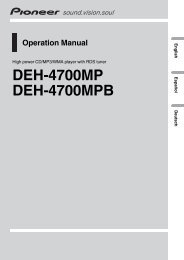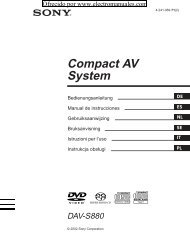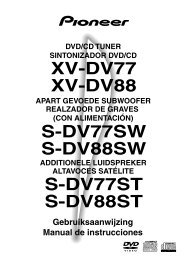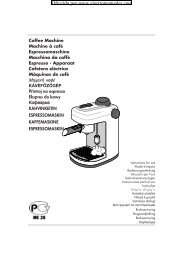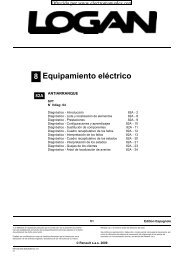lijadora triangular smerigliatrice triangolare - Electromanuals.org
lijadora triangular smerigliatrice triangolare - Electromanuals.org
lijadora triangular smerigliatrice triangolare - Electromanuals.org
Create successful ePaper yourself
Turn your PDF publications into a flip-book with our unique Google optimized e-Paper software.
Ofrecido por www.electromanuales.com<br />
General Safety advice / Preparing for use<br />
Q Have you understood<br />
everything?<br />
J Once you have made yourself familiar with the<br />
instructions and advice, the functioning and<br />
handling of your device, you are finally in a<br />
position to start work. Observing the manufacturer‘s<br />
instructions and advice will maximise<br />
your safety while working with the device.<br />
Q Preparing for use<br />
Take note of the mains voltage. The mains voltage<br />
at the mains socket must match that shown on the<br />
rating plate on the device. Devices marked with<br />
230 V can also be operated at 220 V.<br />
m CAUtIon! Make sure that the device is<br />
switched off before you connect it to the mains<br />
supply.<br />
note: Always switch on the delta sander before<br />
bringing it into contact with the workpiece material.<br />
Switching on the device:<br />
j Move the ON / OFF switch 1 forwards into<br />
setting “I”.<br />
Switching off the device:<br />
j Move the ON / OFF switch 1 backwards into<br />
setting “0”.<br />
Selecting the oscillation speed:<br />
You can preselect the oscillation speed you require<br />
using the oscillation speed setting wheel 2 . You<br />
can also change the speed whilst you are working.<br />
The way to determine the optimum oscillation<br />
speed for your task is to carry out a practical test.<br />
Setting 1 = lowest oscillation speed /<br />
Setting max. = highest oscillation speed<br />
Q Vacuum dust extraction<br />
WArnIng! DAngEr oF FIrE! There is<br />
the danger of fire when working with electrical<br />
devices that have a dust box or can be connected<br />
to a vacuum cleaner. Under certain conditions the<br />
26 GB/MT<br />
wood dust in the dust extraction bag (or in the vacuum‘s<br />
dust bag) may ignite, e.g. as a result of flying<br />
sparks generated when abrading metals or metal<br />
objects left in wood. This can happen particularly if<br />
the wood dust is mixed with paint residue or other<br />
chemicals and the abraded particles are hot from<br />
prolonged abrasion. Therefore you must empty the<br />
device’s dust collection box and the vacuum cleaner’s<br />
dust bag before taking a break or stopping<br />
work and always avoid overheating of the abraded<br />
particles and the device.<br />
Wear a dust mask!<br />
WArnIng! Always pull the mains plug is<br />
out of the socket before doing any work on the<br />
device.<br />
Q Adapter for external vacuum<br />
extraction (with reducer piece)<br />
Connection:<br />
j Push the adapter for external vacuum extraction<br />
7 into the dust extraction spout 4 .<br />
When doing this observe the guide markings<br />
on the device and adapter. Turn the dust<br />
extraction spout to lock in place.<br />
j If it is necessary to use the reducer piece 8 ,<br />
push the reducer piece into the adapter for<br />
external vacuum extraction 7 .<br />
j Push the hose of a suitable dust extraction de<br />
vice approved for that purpose (e.g. a workshop<br />
vacuum cleaner) on to the adapter for<br />
external vacuum extraction 7 or the reducer<br />
piece 8 .<br />
removal:<br />
j Pull the hose of the dust extraction device off<br />
the adapter for external vacuum extraction 7 .<br />
j Pull off the adapter for external vacuum extraction<br />
7 (with the reducer piece 8 if used).



